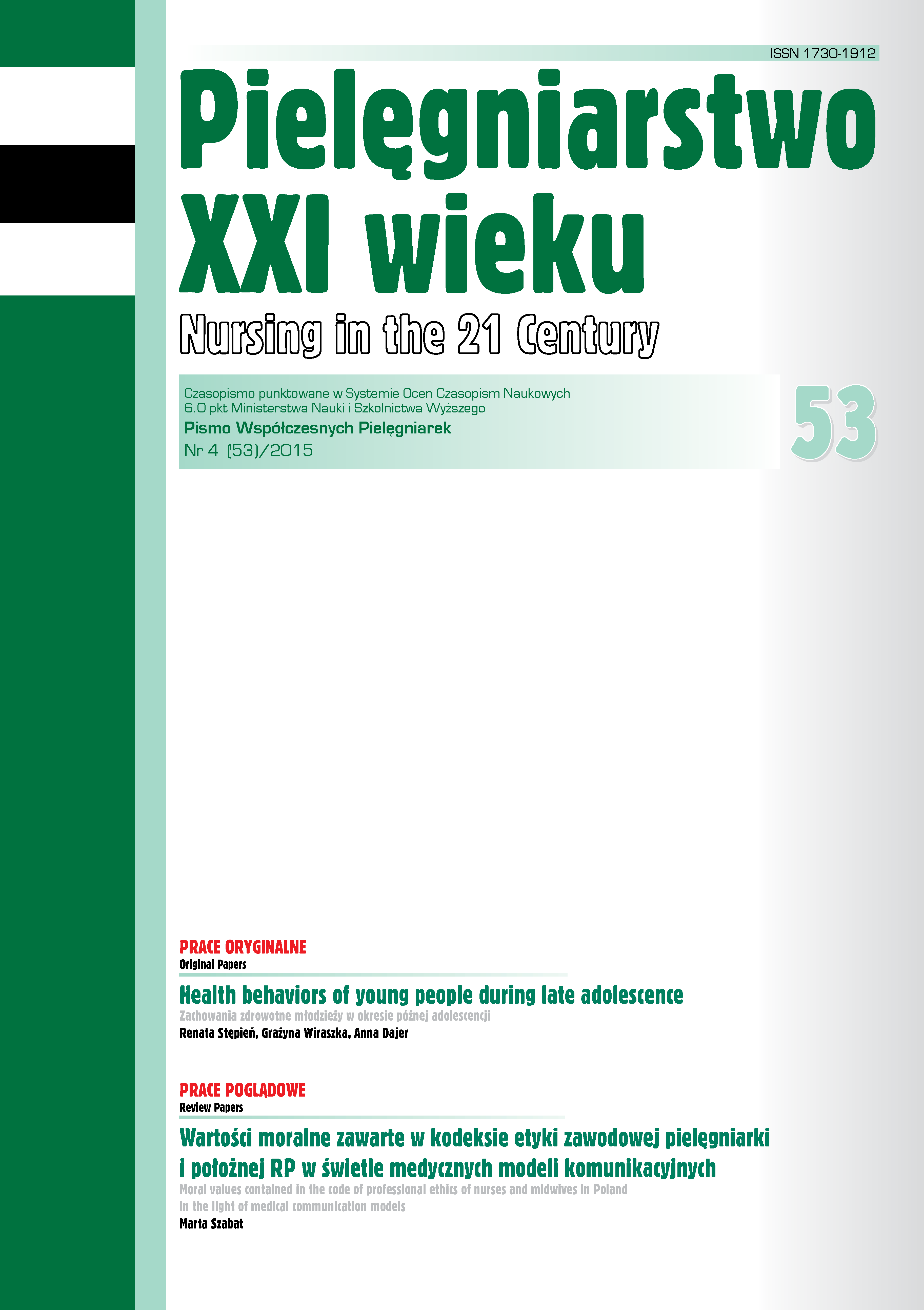Sleep disturbances in nurses enrolled in part-time studies
DOI:
https://doi.org/10.12923/p21w-2015-4/56Keywords:
sleep, insomnia, part-time studies, nursesAbstract
SLEEP DISTURBANCES IN NURSES ENROLLED IN PART-TIME STUDIES
Aim. The aim of this study was to assess the prevalence of sleep disorders among nurses enrolled in part-time studies and to identify the key factors affecting the sleep quality.
Material and methods. The study was conducted on part-time student-nurses majoring in nursing. Sleep disorders were described using the Athens Insomnia Scale and the FIRST scale, as well as the author’s questionnaire. Data were analysed using Mann-Whitney U tests, ANOVA, Kruskal-Wallis and appropriate post-hoc tests. A significance criterion of P<0.05 was used throughout the study.
Results. Sleep disorders were found in most student nurses – almost a half of them were at-risk of insomnia due to inadequate sleep hygiene. The main factors affecting sleep included nurses’ anxiety about their academic performance, stress, workload and shift work. Lack of sleep affected work performance the following day, leading to fatigue, increased daytime sleepiness, deterioration of concentration and irritability.
Conclusion. Some individuals may not be aware about the relationship between one’s lifestyle and sleep quality which contributes to poor sleep quality and deteriorates one’s functioning during the day. In turn, this may lead to lower nursing care quality and it may also put additional strain on home chores.
References
1. Wojtas A, Ciszewski S. Epidemiologia bezsenności. Psychiatria. 2011; 8(3): 79-83.
2. Wilson SJ, Nutt DJ, Alford C, et al. British Association for Psychopharmacology consensus statement on evidence-based treatment of insomnia, parasomnias and circadian rhythm disorders. J Psychopharmacol. 2010; 24: 1577-1601.
3. Szelenberger W. Hipersomnie pochodzenia ośrodkowego. Pneumon Alergol Pol. 2007; 75(1): 80-86.
4. Santorek-Strumiłło E, Zawilska JB, Misiak P, i wsp. Wpływ pracy zmianowej na rytmy okołodobowe – badania porównawcze na pracownikach służby zdrowia i policjantach. Przeg Lek. 2012; 69(3): 103-106.
5. Kasperczyk J, Jośko J. Analiza czynników odpowiedzialnych za złą jakość snu u studentów Śląskiego Uniwersytetu Medycznego. Hygeia Public Health. 2012; 47(2): 191-195.
6. Pierzchała W, Oławska-Dzierżęga A. Zaburzenia snu w chorobach wewnętrznych. Sen. 2004; 4(4): 117-122.
7. Prejbisz A, Kabat M, Kluk M, i wsp. Zaburzenia snu a nadciśnienie tętnicze. Nadciśn. Tętn. 2010;14(5): 411-419.
8. Sułkowska-Olejarz A, Chołody P, Wysokiński A, i wsp. Wpływ zaburzeń snu na występowanie napadowego migotania przedsionków. Medycyna Ogólna i Nauki Zdrowiu. 2012; 18(1): 27-30.
9. Soldatos CR, Dikeos DG, Paparrigopoulos TJ. Athens Insomnia Scale: validation of an instrument based on ICD-10 criteria. J. Psychosom. Res. 2000; 48(6): 555-560.
10. Drake C, Richardson G, Roehrs T, et al. Vulnerability to stress-related sleep disturbance and hyperarousal. Sleep. 2004; 27(2): 285-291. 11. Fornal – Pawłowska M, Wołyńczuk – Gmaj D, Szelenberger W. Walidacja Ateńskiej Skali Bezsenności. Psychiatr Pol. 2011; XLV(2): 211-221.
11. Fornal-Pawłowska M, Skalski M, Szelenberger W. Badanie predyspozycji do bezsenności za pomocą skali FIRST. Sen. 2007; 7(2): 104-109.
12. Waage S, Pallesen S, Moen BE, et al. Predictors of shift work disorder among nurses: a longitudinal study. Sleep Med. 2014;15(12): 1449-1455.
13. Øyane NM, Pallesen S, Moen BE, et al. Associations between night work and anxiety, depression, insomnia, sleepiness and fatigue in a sample of Norwegian nurses. PLoS One. 2013; 8(8): e70228.
14. Bjorvatn B, Dale S, Hogstad-Erikstein R, et al. Self-reported sleep and health among Norwegian hospital nurses in intensive care units. Nurs Crit Care. 2012; 17(4): 180-188.
15. Geiger-Brown J, Rogers VE, Han K, et al. Occupational screening for sleep disorders in 12-h shift nurses using the Berlin Questionnaire. Sleep Breath. 2013; 17(1): 381-388.
16. Szelenberger W. Neurobiologia snu. Pneumon i Alergol Pol. 2007; 75(1): 3-8.
17. Zięba M, Dębska G, Ławska W, i wsp. Jakość snu młodzieży na przykładzie studentów pielęgniarstwa Podhalańskiej Państwowej Wyższej Szkoły Zawodowej w Nowym Targu. Probl Pielęg. 2008; 16(4): 374-378.
18. Shepertycky MR, Banno K, Kryger MH. Differences between men and women in the clinical presentation of patients diagnosed with obstructive sleep apnea syndrome. Sleep. 2005; 28(3): 309-314.
19. Young T, Rabago D, Zgierska A, et al. Objective and subjective sleep quality in premenopausal, erimenopausal, and postmenopausal women in Wisconsin Sleep Cohort Study. Sleep. 2003; 26(6): 667-672.
Downloads
Published
Issue
Section
License
Copyright (c) 2015 Lucyna Tomaszek, Grażyna Cepuch, Beata Fugie (Autor)

This work is licensed under a Creative Commons Attribution 4.0 International License.




